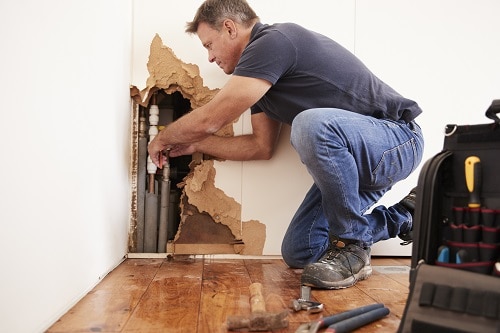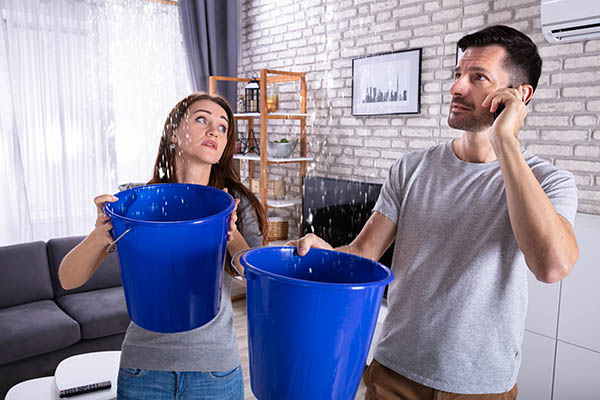Water Damage Restoration frequently asked questions answered
Wiki Article
Water Damage Restoration 101: Recognizing the Process and Cost
Water damage can strike unexpectedly, leaving property owners in a state of complication. Understanding the remediation procedure is crucial for effective recovery. From assessing the damage to choosing the ideal company, each action impacts the total result and price. Variables such as the kind of water damage and necessity also play a significant function. What are the details methods used in remediation, and how can one plan for potential expenses?Sorts Of Water Damage
Water damage can emerge from numerous resources, each providing special difficulties for reconstruction. The three primary types of water damage are classified based upon contamination degrees: clean water, gray water, and black water. Tidy water originates from sources like damaged pipes or rainwater, posing marginal wellness dangers. Gray water, that includes wastewater from sinks or cleaning equipments, has pollutants that may create discomfort or ailment if consumed. Black water, the most hazardous group, originates from sewage or floodwaters, containing harmful microorganisms and microorganisms. Each type requires particular restoration strategies and safety and security steps to effectively mitigate and attend to the damage health and wellness risks. Recognizing these distinctions is important for home owners and experts entailed in the water damage remediation procedure.Initial Analysis and Examination
A thorough preliminary evaluation and inspection are vital action in the water damage repair procedure. This stage begins with an expert assessing the extent of the damage, identifying the source of the water invasion, and establishing the type of water entailed - Water Damage Restoration. Professionals utilize specific devices to determine wetness levels in different materials, such as wall surfaces, floorings, and furniture. Additionally, they evaluate structural integrity and potential health hazards, consisting of mold growth. The searchings for from this inspection educate the reconstruction strategy, leading essential actions and resource allotment. Precise documentation of the damage is important for insurance claims and future referral. Generally, this initial evaluation lays the groundwork for reliable restoration, guaranteeing a detailed response to the details circumstance available

Water Extraction Strategies
Adhering to the preliminary evaluation, efficient water extraction strategies are utilized to mitigate damage and protect against further concerns. These methods involve the usage of customized tools such as submersible pumps and industrial-grade vacuums. The option of method depends on the quantity of water existing and the kind of materials affected. For standing water, completely submersible pumps are typically used for fast removal, while vacuum cleaners are suitable for drawing out water from carpetings and furniture. Additionally, progressed techniques like water extraction floor coverings may be used for hard-to-reach areas. The objective is to remove as much water as feasible, minimizing the capacity for mold and mildew growth and architectural damage. Prompt and reliable water extraction is crucial in the overall water damage reconstruction process.Drying and Dehumidification Process
As soon as the water extraction is total, the drying out and dehumidification procedure ends up being critical to restoring the afflicted location. This phase usually utilizes industrial-grade dehumidifiers and air moving companies to efficiently lower wetness degrees. The dehumidifiers draw in wet air, eliminating excess moisture, while air moving companies circulate air to speed up dissipation. Surveillance equipment is frequently made use of to track moisture and temperature levels, making certain ideal drying conditions. The duration of this process can vary relying on the extent of the water damage and environmental elements. It is vital to extensively completely dry all influenced products, consisting of wall surfaces, floor covering, and furnishings, to avoid mold development and architectural damage. Proper implementation of this step is critical for an effective restoration outcome.Cleaning and Sanitizing Affected Areas

First Evaluation and Inspection
Prior to beginning any kind of remediation initiatives, a detailed initial analysis and evaluation of the influenced areas are essential for efficient cleansing and sterilizing. This procedure entails recognizing the degree of water damage, determining the resource of the water invasion, and examining the materials influenced. Examiners generally look for indications of mold development, structural stability concerns, and harmed valuables. The analysis also includes examining moisture levels utilizing customized equipment to ensure no surprise water pockets remain, as these can result in more problems. Recording the searchings for is essential for preparing the following action in the reconstruction process. A comprehensive preliminary analysis makes it possible for restoration professionals to design a targeted technique for efficient cleaning and sterilizing, ultimately decreasing damage and health risks.Cleansing Strategies and Products
Effective cleaning and sanitizing of water-damaged areas require a Water Damage Restoration variety of products and techniques tailored to the particular products influenced. For permeable surface areas like drywall and carpeting, extraction methods are vital to remove excess moisture, followed by deep cleaning with specialized cleaning agents. Non-porous products such as tile or steel can be cleaned making use of commercial-grade cleansers that effectively remove pollutants. Vapor cleaning is one more effective technique, specifically for carpetings and furniture, as it utilizes heats to eliminate bacteria and mold and mildew. Furthermore, green items are significantly prominent for their security and efficiency. Eventually, choosing the appropriate cleansing techniques and products not just ensures immediate sanitation however also help in avoiding additional damage and carcinogen connected with water invasion.Sanitization and Disinfection Methods
When dealing with water damage, proper sanitization and sanitation approaches are important to guarantee the safety and security and wellness of the afflicted setting. After first cleaning, surfaces must be treated with ideal anti-bacterials to get rid of pathogens, mold and mildew, and germs that flourish in moist problems. Typical methods include using EPA-approved chemical anti-bacterials, which can be applied with splashing or wiping strategies. Additionally, ultraviolet (UV) light systems can successfully sanitize areas by counteracting microorganisms without extreme chemicals. The option of method commonly depends on the type of products influenced and the extent of contamination. Eventually, thorough sanitization not only recovers a secure living space however also assists prevent future health dangers related to sticking around moisture and mold and mildew growth.
Repair Work and Restoration Options

Variables Influencing Restoration Prices
The extent of water damage straight influences the remediation sets you back property owners can anticipate to incur. Aspects such as the resource of the water, the duration of exposure, and the damaged materials significantly affect prices. Tidy water damage from a busted pipe is typically much less pricey to restore compared to damage created by sewage (Water Damage Restoration). In addition, the level of contamination determines the requirement for specialized cleaning and disposal solutions, even more increasing costs. Geographic area also plays a duty, as regional labor prices and accessibility of restoration solutions can vary. The urgency of the reaction impacts prices; quicker treatments typically lead to lower overall expenditures by preventing further damage. Understanding these factors is vital for homeowners when approximating reconstruction pricesThe 3 main types of water damage are categorized based on contamination levels: clean water, grey water, and black water. A thorough initial analysis and examination are crucial actions in the water damage reconstruction process. For standing water, submersible pumps are normally made use of for rapid elimination, while vacuums are perfect for extracting water from carpetings and furniture. The degree of water damage directly influences the repair costs homeowners can anticipate to incur. Tidy water damage from a damaged pipeline is normally less pricey to bring back contrasted to damage triggered by sewage.
Report this wiki page